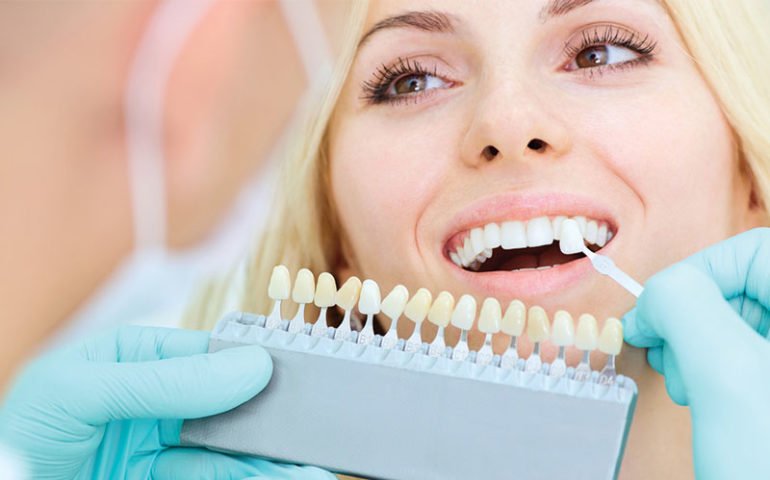
Understanding Laminated and Porcelain Crowns: What Are They?
The Benefits of Laminated and Porcelain Crowns: Restoring Dental Aesthetics
Laminated vs. Porcelain Crowns: Which Option is Right for You?
The Process of Getting Laminated or Porcelain Crowns: What to Expect
The next visit will involve the placement of the permanent crowns. Your dentist will remove the temporary crowns, check the fit and appearance of the final crowns, and make any necessary adjustments. The crowns will then be permanently bonded to your teeth using a dental adhesive. Your dentist will ensure proper alignment, bite, and aesthetics before finalizing the placement. Following the placement, you will be provided with instructions on how to care for your new crowns and maintain good oral hygiene. Regular check-ups will be scheduled to monitor the condition of the crowns and your overall oral health.
These steps may vary depending on the specific case and the type of crowns being used. Your dentist will guide you through the process and address any concerns or questions you may have along the way.
Laminated and Porcelain Crowns: Indications and Treatment Planning
• Dental Damage: Crowns are often recommended to restore teeth with significant damage, such as severe decay, fractures, or large fillings. They provide strength and protection to the compromised tooth structure, preventing further damage and preserving its function.
• Aesthetic Enhancement: Both laminated and porcelain crowns are effective in improving dental aesthetics. They can address issues like tooth discoloration, uneven shape, or size discrepancies, creating a more pleasing and uniform smile.
• Tooth Misalignment: In some cases, laminated and porcelain crowns can be utilized to correct minor tooth misalignment. They can reshape and recontour teeth, improving their alignment and creating a more harmonious smile.
• Tooth Discoloration: Stubborn tooth stains or intrinsic discoloration that does not respond to teeth whitening treatments can be effectively concealed with laminated or porcelain crowns. The crowns can be customized to match the desired shade, providing a bright and uniform appearance.
Treatment planning for laminated and porcelain crowns involves a comprehensive assessment of your oral health, dental concerns, and desired outcome. Your dentist will consider factors such as tooth condition, occlusion (bite), gum health, and aesthetic goals to develop a personalized treatment plan. They will discuss the benefits, risks, and alternatives to crowns and present you with the most suitable options for your specific needs.
Caring for Laminated and Porcelain Crowns: Tips for Long-lasting Results
• Maintain Good Oral Hygiene: Brush your teeth at least twice a day using a soft-bristled toothbrush and a non-abrasive toothpaste. Floss daily to clean between the teeth and along the gumline. Good oral hygiene helps prevent gum disease, decay, and staining.
• Avoid Excessive Force: While crowns are durable, they can still be susceptible to damage from excessive force. Avoid habits like biting on hard objects, opening packages with your teeth, or grinding your teeth. If you have a teeth-grinding habit, your dentist may recommend a nightguard to protect your crowns and natural teeth.
• Limit Staining Foods and Drinks: Although porcelain crowns are resistant to staining, it's still advisable to limit the consumption of foods and drinks that can discolor teeth, such as coffee, tea, red wine, and dark-colored berries. If you do consume staining substances, rinse your mouth with water afterward.
• Regular Dental Check-ups: Maintain regular dental visits for professional cleanings and examinations. Your dentist will assess the condition of your crowns, check your oral health, and address any concerns. Prompt identification of any issues can help prevent complications and ensure the longevity of your crowns.
• Avoid Tobacco Use: Tobacco products, including smoking and chewing tobacco, can stain and damage your crowns. Quitting tobacco use not only improves your oral health but also helps maintain the appearance and longevity of your crowns.
Smile Transformation: Enhancing Dental Appearance with Laminated and Porcelain Crowns
- Aesthetically Pleasing: Laminated and porcelain crowns are designed to closely resemble natural teeth in color, shape, and translucency. Their lifelike appearance allows them to seamlessly blend with your existing teeth, resulting in a harmonious and natural-looking smile. They can conceal imperfections such as tooth discoloration, chips, cracks, or misshapen teeth, transforming your smile into a more attractive and youthful one.
• Customizable: Laminated and porcelain crowns are highly customizable, allowing your dentist to tailor the shape, size, and shade to match your facial features, complexion, and personal preferences. This customization ensures that your new smile looks natural and complements your overall appearance. Your dentist will work closely with you to achieve the desired outcome, ensuring that your new crowns enhance your facial aesthetics and create a smile you can be proud of.
• Symmetry and Alignment: If you have teeth that are misaligned, crooked, or have gaps between them, laminated and porcelain crowns can help improve their alignment and create a more symmetrical smile. By carefully shaping and positioning the crowns, your dentist can enhance the overall balance and proportion of your teeth, transforming the appearance of your smile.
• Instant Whitening: Laminated and porcelain crowns can effectively cover deep stains and discoloration that are resistant to traditional teeth whitening methods. Whether caused by genetics, medication, or lifestyle factors, these crowns can provide a white and vibrant smile instantly. You can achieve a bright, consistent color across all your visible teeth, enhancing your overall dental appearance.
• Long-lasting Results: Laminated and porcelain crowns are known for their durability and longevity. With proper care and maintenance, they can last for many years, providing you with a beautiful smile for an extended period. Their resistance to staining and chipping ensures that your smile remains vibrant and attractive over time.
Under the guidance of an experienced dentist, laminated and porcelain crowns can create a stunning smile transformation. They offer a comprehensive solution for addressing multiple cosmetic concerns, restoring dental aesthetics, and boosting your self-confidence.
The Role of Laminated and Porcelain Crowns in Restorative Dentistry
• Tooth Protection: Laminated and porcelain crowns provide a protective shield for teeth that are weakened or compromised due to decay, fractures, or large fillings. By covering the entire tooth surface, crowns help prevent further damage and reinforce the structural integrity of the tooth. They act as a durable barrier, preventing bacteria and debris from penetrating the tooth, and reducing the risk of infection or further decay.
• Stability and Strength: Crowns offer stability and strength to weakened teeth. They can restore chewing function and bite strength, allowing you to enjoy a varied diet without discomfort. Crowns distribute the forces exerted during biting and chewing evenly across the tooth, minimizing the risk of fractures and preserving the remaining healthy tooth structure.
• Restoration of Function: When a tooth is significantly damaged or decayed, its functionality can be compromised. Laminated and porcelain crowns effectively restore the function of such teeth, enabling you to bite, chew, and speak with ease. With the help of crowns, you can regain normal oral function and enjoy improved overall oral health.
• Natural Appearance: Laminated and porcelain crowns are designed to closely resemble natural teeth, both in terms of color and shape. Their lifelike appearance ensures that the restored tooth seamlessly blends with the adjacent teeth, creating a natural and aesthetically pleasing smile. Restorative dentistry aims to achieve functional improvements while maintaining a natural dental appearance, and crowns play a crucial role in achieving this goal.
• Customized Restoration: Each laminated or porcelain crown is custom-made to match your natural teeth in size, shape, and color. The crown is carefully fabricated to blend seamlessly with your existing dentition and fit comfortably within your bite. This customized restoration ensures that your crown feels and functions like a natural tooth, providing you with a comfortable and functional outcome.
Laminated and porcelain crowns have become a cornerstone of restorative dentistry, offering durable and aesthetically pleasing solutions for tooth restoration. With their ability to protect, strengthen, and restore damaged teeth, they play a significant role in improving both the form and function of your smile.
Repairing Damaged Teeth: How Laminated and Porcelain Crowns Can Help
• Tooth Fractures: Teeth can suffer from fractures due to trauma, decay, or biting on hard objects. Laminated and porcelain crowns can provide a durable and protective covering for fractured teeth, preventing further damage and restoring their strength. The crown encapsulates the damaged tooth, holding it together and preventing the fracture from worsening.
• Severe Tooth Decay: When tooth decay has progressed extensively, traditional fillings may not provide sufficient support. Laminated and porcelain crowns offer a more comprehensive solution for restoring teeth with severe decay. The decayed portion of the tooth is removed, and the crown is placed over the remaining healthy tooth structure, providing a strong and natural-looking restoration.
• Large Fillings: Teeth with large fillings may become weakened over time and susceptible to fractures. Laminated and porcelain crowns can reinforce these teeth, protecting them from further damage and providing long-term stability. The crown covers the entire tooth, strengthening it and preventing fractures that can occur with extensive fillings.
• Worn or Eroded Teeth: Teeth that have been worn down or eroded due to factors such as teeth grinding or acid erosion can be effectively restored with laminated and porcelain crowns. These crowns rebuild the natural shape and size of the affected teeth, improving their function and aesthetics.
By repairing damaged teeth with laminated and porcelain crowns, you can regain the strength, function, and appearance of your natural teeth. Your dentist will assess the extent of the damage and recommend the appropriate treatment plan, which may include the placement of crowns to restore and protect the affected teeth.
Laminated and Porcelain Crowns for Tooth Misalignment: Improving Alignment and Aesthetics
• Reshaping and Contouring: Laminated and porcelain crowns can be used to reshape and contour teeth, making them appear straighter and more aligned. By carefully sculpting the crowns, your dentist can create the illusion of a more harmonious smile, improving the overall alignment and symmetry of your teeth.
• Filling Gaps: If you have small gaps between your teeth, laminated and porcelain crowns can be customized to fill those spaces, giving the appearance of a straighter smile. The crowns are designed to match the size and shape of adjacent teeth, seamlessly closing the gaps and creating a more uniform dental alignment.
• Correcting Minor Tooth Rotation: In cases where teeth have minor rotations or are slightly turned, laminated and porcelain crowns can be used to mask the misalignment and create the appearance of straighter teeth. The crowns are precisely crafted to align with the surrounding teeth, providing a symmetrical and aesthetically pleasing result.
It's important to note that laminated and porcelain crowns are suitable for minor cases of tooth misalignment. For more severe misalignments or orthodontic concerns, orthodontic treatment such as braces or clear aligners may be more appropriate. Your dentist will evaluate your specific case and recommend the most suitable treatment option to achieve the desired alignment and aesthetics for your smile.
Using laminated and porcelain crowns to address tooth misalignment offers a conservative alternative to orthodontic treatment, providing an aesthetic improvement while preserving tooth structure. It's important to consult with your dentist to determine the best approach for your individual needs and goals.
The Durability of Laminated and Porcelain Crowns: Longevity and Maintenance
• Longevity: Laminated and porcelain crowns have an average lifespan of 10 to 15 years, but they can last even longer with proper care. Factors such as oral hygiene practices, diet, habits (like teeth grinding), and regular dental check-ups can influence the lifespan of the crowns. By maintaining good oral hygiene and following your dentist's recommendations, you can maximize the longevity of your crowns.
• Oral Hygiene: Maintaining proper oral hygiene is crucial for the durability of laminated and porcelain crowns. Brush your teeth at least twice a day using a soft-bristled toothbrush and non-abrasive toothpaste. Floss daily to remove plaque and debris from between the teeth and around the crown margins. Additionally, use an antimicrobial mouthwash to reduce bacterial buildup. Regular dental check-ups and professional cleanings will help ensure that your crowns remain in good condition.
• Avoid Excessive Force: While laminated and porcelain crowns are strong, they can still be susceptible to damage from excessive force. Avoid habits like biting on hard objects, opening packages with your teeth, or grinding your teeth. If you have a teeth-grinding habit, your dentist may recommend a nightguard to protect your crowns and natural teeth from the forces of grinding.
• Stain Prevention: Laminated and porcelain crowns are resistant to staining, but certain habits and foods can still cause discoloration over time. Limit your consumption of stain-causing foods and beverages like coffee, tea, red wine, and dark-colored berries. If you do consume staining substances, rinse your mouth with water afterward. Additionally, regular dental cleanings can help remove surface stains and maintain the aesthetics of your crowns.
• Regular Dental Check-ups: Schedule regular dental check-ups every six months or as recommended by your dentist. These visits allow your dentist to monitor the condition of your crowns, check the surrounding teeth and gums, and address any concerns. Early detection and timely intervention can help prevent complications and extend the lifespan of your crowns.
Laminated and Porcelain Crowns: Addressing Tooth Discoloration and Stains
• Intrinsic Discoloration: Intrinsic tooth discoloration refers to stains that occur within the tooth structure, often caused by factors such as genetics, certain medications, or dental trauma. Laminated and porcelain crowns are ideal for covering intrinsic stains that do not respond well to teeth whitening treatments. The crowns can be custom-made to match the desired shade, effectively concealing the discoloration and providing a uniform and brighter appearance.
• Extrinsic Stains: Extrinsic stains occur on the outer surface of the teeth and are typically caused by substances such as coffee, tea, tobacco, or certain foods. Laminated and porcelain crowns are resistant to staining, making them an excellent choice for individuals with a history of extensive extrinsic staining. The crowns can be placed over the stained teeth, providing a clean and vibrant appearance that remains unaffected by external staining agents.
• Consistent Color: Laminated and porcelain crowns allow you to achieve a consistent color and shade across your visible teeth. If you have teeth with varying shades or uneven color distribution, the crowns can be customized to match the desired color, creating a balanced and uniform smile. This consistency enhances the overall aesthetics of your smile and gives you a more confident appearance.
By addressing tooth discoloration and stains with laminated and porcelain crowns, you can achieve a brighter, whiter, and more attractive smile. Your dentist will assess the nature and cause of the discoloration to determine the appropriate shade and type of crown that will provide the best aesthetic results. With proper care and maintenance, your new crowns can maintain their color and brightness for years to come, giving you a beautiful and confident smile.
All About the Laminated and Porcelain Crown Placement Procedure
• Consultation and Treatment Planning: During your initial consultation, your dentist will examine your teeth, discuss your concerns and goals, and determine if laminated or porcelain crowns are the right option for you. X-rays or dental impressions may be taken to assess the condition of your teeth and plan the treatment.
• Tooth Preparation: During the first appointment, your dentist will prepare the tooth that will receive the crown. This involves removing a thin layer of the outer tooth structure to create space for the crown. Local anesthesia may be used to ensure your comfort during the procedure. If necessary, your dentist will build up the tooth to provide a stable foundation for the crown.
• Impression Taking: After tooth preparation, your dentist will take impressions of the prepared tooth and the surrounding teeth. These impressions will serve as a guide for the dental laboratory to create a custom crown that matches the size, shape, and color of your natural teeth. Temporary crowns may be placed to protect the prepared tooth while the final crown is being fabricated.
• Crown Fabrication: The impressions are sent to a dental laboratory where skilled technicians create your custom laminated or porcelain crown. This process typically takes a few weeks. The crown is meticulously crafted to match your natural teeth in color, shape, and size, ensuring a seamless blend with your smile.
• Crown Placement: Once your final crown is ready, you will return to your dentist for the placement appointment. The temporary crown is removed, and your dentist will check the fit, color, and aesthetics of the final crown. Adjustments may be made to ensure a precise fit and proper bite alignment. Once both you and your dentist are satisfied with the crown's appearance and fit, it will be permanently bonded to your tooth using dental cement or adhesive.
• Final Adjustments and Polishing: After the crown is secured in place, your dentist will make any final adjustments to ensure a comfortable bite and natural appearance. The crown will be polished to a smooth and lustrous finish, blending seamlessly with your surrounding teeth.
• Post-Placement Care: Your dentist will provide you with specific instructions on how to care for your new crown. It's important to maintain good oral hygiene practices, such as regular brushing and flossing, to keep your crown and surrounding teeth healthy. Attend regular dental check-ups to ensure the crown remains in excellent condition and to address any concerns.
By following these steps, you can expect a successful and precise placement of your laminated or porcelain crown, restoring the aesthetics and functionality of your tooth. Your dentist will guide you through each stage of the process and address any questions or concerns you may have.
Laminated and Porcelain Crowns: Frequently Asked Questions
Laminated and porcelain crowns are designed to be long-lasting, but they may need replacement after several years due to wear or damage. With proper care and maintenance, they can provide durable results for a decade or more.
Will getting a crown to be painful?
The crown placement procedure is typically performed under local anesthesia, ensuring that you feel little to no discomfort during the process. Some sensitivity or mild discomfort may be experienced after the anesthesia wears off, but this can be managed with over-the-counter pain medications.
How do I care for my laminated or porcelain crown?
Maintain good oral hygiene practices, including brushing your teeth twice a day, flossing daily, and using non-abrasive toothpaste. Avoid biting or chewing on hard objects and refrain from habits like teeth grinding. Regular dental check-ups are essential for monitoring the condition of your crown and overall oral health.
Can I whiten my laminated or porcelain crown?
Laminated and porcelain crowns do not respond to traditional teeth whitening treatments. If you want to whiten your natural teeth, it's best to do so before getting the crown to ensure a consistent shade. If the crown becomes stained or discolored over time, it may need replacement to restore its original appearance.
Can I eat normally with a laminated or porcelain crown?
Yes, you can eat a wide range of foods with a laminated or porcelain crown. These crowns are designed to withstand the forces of biting and chewing. However, it's advisable to avoid excessively hard or sticky foods that could potentially damage the crown or cause it to become dislodged.
How much do laminated and porcelain crowns cost?
The cost of laminated and porcelain crowns can vary depending on factors such as the location, complexity of the case, materials used, and individual dental practices. It's best to consult with your dentist for an accurate cost estimate and to inquire about any dental insurance coverage that may apply.
Can a crown fall off?
While rare, a crown can become dislodged or come off. This may occur due to factors such as underlying tooth decay, inadequate bonding, or trauma. If your crown becomes loose or falls off, contact your dentist immediately for evaluation and appropriate reattachment or replacement.
Case Studies: Before and After Laminated and Porcelain Crown Restorations
Case 1: Patient A had chipped and discolored front teeth that affected their smile. Laminated crowns were placed on the affected teeth, restoring their natural shape, concealing the discoloration, and creating a beautifully aligned and symmetrical smile.
Case 2: Patient B had severe tooth decay in a molar that had resulted in significant damage. A porcelain crown was placed on the decayed tooth, restoring its functionality and providing a strong and aesthetically pleasing restoration that seamlessly blended with the surrounding teeth.
Case 3: Patient C had gaps between their front teeth that caused self-consciousness. Porcelain crowns were custom-made to close the gaps and create a more aligned and harmonious smile. The final result was a transformation that significantly enhanced the patient's dental aesthetics.
These case studies highlight the remarkable improvements that can be achieved with laminated and porcelain crowns. Each case is unique, and the treatment is tailored to the individual's specific needs and desired outcome. Your dentist can evaluate your case, provide you with similar case studies relevant to your situation, and help you envision the potential results of laminated or porcelain crowns for your smile transformation.
Our Patients' Comments
DANIELO JASON
6 PACK j’avais du mal a faire du sport et de suivre des regimes alimentaires mais sans resultat alors cette annee je me suis dirigé vers REFERENCE ESTHETIQUE en turquie et vraiment je me sens pret pour l’été comme jamais. Merci de m’avoir redonner confiance en moi.
BAHIJA BELHAJ
MEME KUCULTME La clinique est bien situé par rapport au metrobus station, les guichets bancaire sont juste a coté, le market est dont vous aurez besoin, j’étais labas pour faire une reduction mammaire, je ne me suis jamais senti bien dans ma peau jusqu’au jour ou j’ai décidé de me faire opéré chez REFERENCE ESTHETIQUE a Istanbul, Merci






